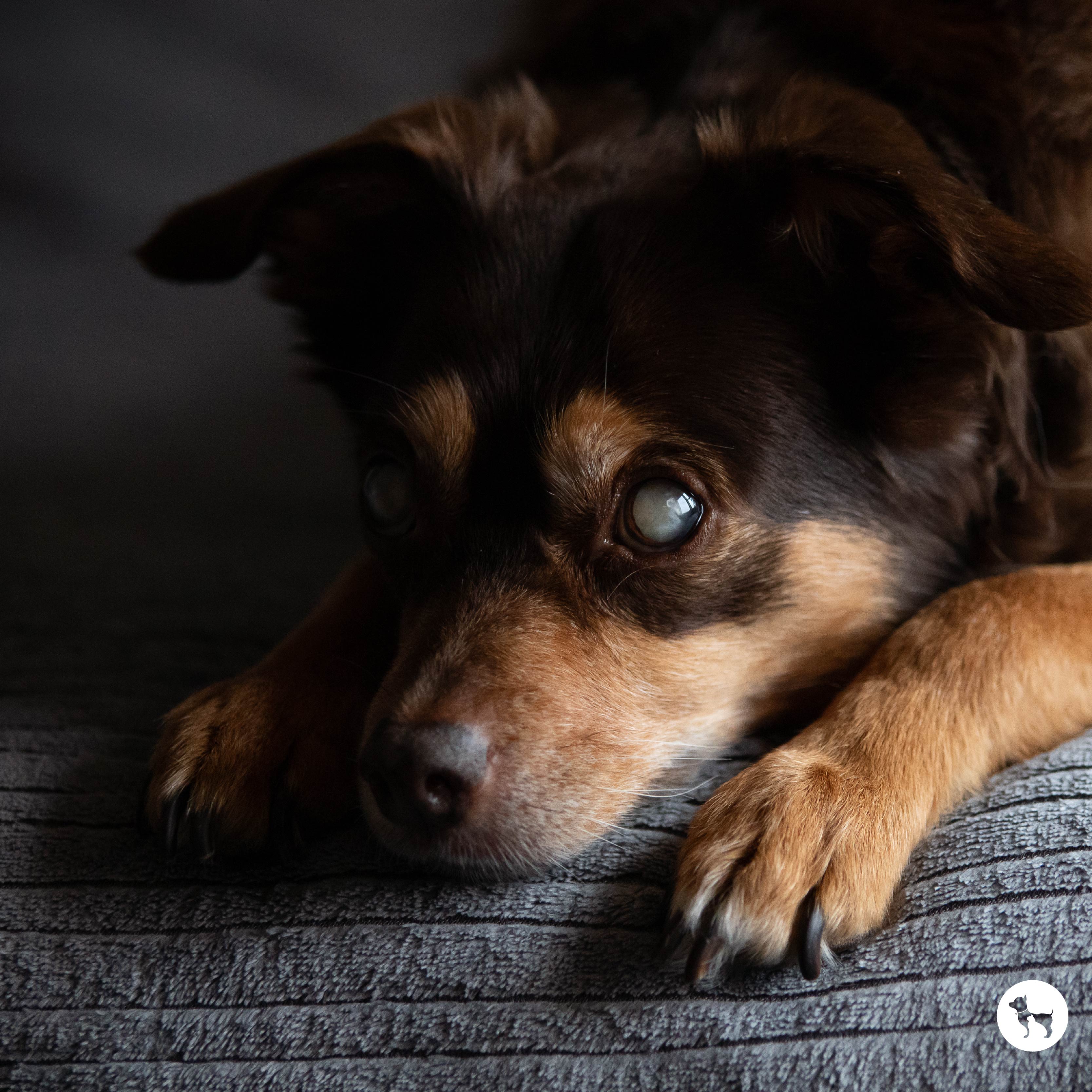
Are you wondering why your dog is unusually apprehensive about using the stairs or isn’t running about and jumping on things as much as before?
It could be that your dog’s vision isn’t what it used to be. This can make them more cautious about moving around, climbing stairs, or jumping on furniture.
This transition can feel confusing for your dog, but small changes to your home, routine, and interactions can help reassure them.
Here’s how you can support your senior dog as their eyesight changes.

Your dog’s hearing and smell are much stronger senses, and as a result, they tend to compensate for any gaps or loss in vision by depending on their hearing more.
This also means that eyesight issues often go unnoticed for a long time.
It’s good to keep an eye out for behaviours that your dog never displayed before, like having a problem with or finding something difficult.
For example:
Don’t forget to keep an eye out for physical symptoms that show up in and around the eyes, which could be age-related or caused by infections.
For example:
If you have a feeling that your pet’s vision is compromised or deteriorating, the first thing to do is consult a vet; and if necessary, they may ask you to visit a specialist.
Conducting certain tests will help you understand what the problem is, how far the vision is compromised and what the underlying causes could be.
The vet will then help you manage your dog’s underlying issue, and prescribe drops, medication or supplements.
Empathy and patience are key, as losing vision can be stressful for dogs, so they’ll need reassurance from you.
The degree to which they need support may vary as a dog’s vision loss could range from finding it difficult to see in low light conditions, to altered depth perception or compromised vision during the day.
Here are ways to support your dog as they adjust:
Imagine having to navigate a space that doesn’t feel familiar any more. It’s a lot of pressure for a senior dog, which can make them increasingly anxious.
Sometimes, they express this anxiety in terms of unusually clingy behaviour, like wanting to stay close to you. If left alone, they may give in to anxiety-fuelled, destructive behaviour.
Instead of punishing them for these responses, be patient and reassuring when they reach out. Supporting them through this transition can deepen trust and strengthen your bond.
Making small alterations to your daily life – like switching to verbal cues rather than depending on visual cues - sends the message that you ‘have their back.’

Familiarity and predictability in their space and routines can offer comfort and reassurance to your dog.
Here are a few ways to create home safety for blind dogs:
Leave your furniture arranged in fixed positions so your dog can memorise the layout.
Stick to a familiar route, and walk more slowly.
Be patient if your dog hesitates to go down a new street.
Keep their water and food bowls in the same place.
Install safety gates at staircases or risky spaces where your dog could potentially injure themselves.
Use textured surfaces or scent markers to indicate turns, and places where they could bump their snouts, etc.
Work with a behaviourist to learn advanced and personalised tips.
Predictability in routine and navigation helps your dog stay independent and rebuilds their confidence which is often lost when their vision is affected.
A balanced diet, paired with the right supplements, will also support their overall wellness as well as eye health.
Remember to:
Opt for senior-friendly diets: Older dogs often fare better with easily digestible proteins and nutrient-rich meals.
Add antioxidants and omega fatty acids: Nutrients like Vitamin A, C, E, lutein and omega-3s can help support eye health and keep their skin and coat healthy.
Take care of their joints: Supplements with glucosamine and chondroitin can reduce stiffness, so your dog feels steadier while walking, even if their vision is compromised.
Encourage hydration: Keep water bowls topped up and consider adding wet dog food to their diet to support hydration.
Schedule routine vet check-ups: Regular visits help you stay on top of age-related changes and get advice on supplements or adjustments suited to your dog’s specific needs.
Focusing on nutrition and wellness ensures your dog stays healthy in body and mind, making it easier for them to adapt to vision changes.
Simple tools and accessories can offer extra support, helping your dog stay safe, confident, and independent, even with limited vision.
For example:
Supportive bedding: A bed like the Royal Snooze offers firm, gel foam comfort that’s easy for seniors to step onto. The slightly raised bolsters provide neck support during naps, while still being low enough for easy access.
Reflective collars and harnesses: These make your dog visible in low light, ensuring people around them stay alert to their presence.
Awareness labels: Tags or labels (like those in our Trooper’s collection) let others know your dog needs gentle handling, without you having to explain.
Weak eyesight doesn’t mean your senior dog can’t continue to live a happy and fulfilling life.
With a little patience, small adjustments, and the right support, your dog can still enjoy their favourite routines and feel confident in their world.
For personalised product recommendations that could aid you in this journey, visit the HUFT store closest to you and chat with one of our staff.